1st March 2014
In just a couple of years, with AB Equipment at the helm, the Mackolines Machines & Hire machine population in New Zealand has exploded from a handful of units to over 120.
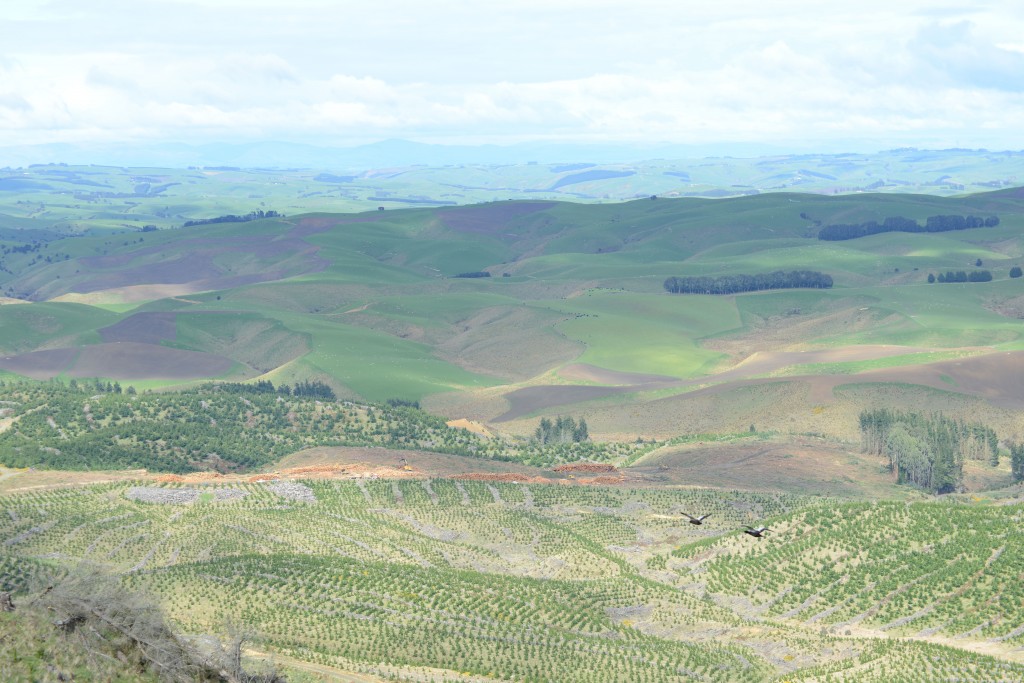
Forestland owned by the Municipality of Dunedin. Look closely and you can see Dave Paul’s 880 on the deck.
It seems that a confluence of factors is behind the exponential growth. A country with especially severe boom and bust forestry industry cycles, New Zealand has of late been enjoying robust demand for pine logs in India, China and Korea. Lower currency valuation in comparison to neighbouring Australia has made the country especially attractive to Asian markets. The strong local economy and the massive rebuild effort following the Christchurch earthquake in 2011 has resulted in a decidedly firmer domestic market for higher grade logs marketed to local sawmills for domestic consumption.
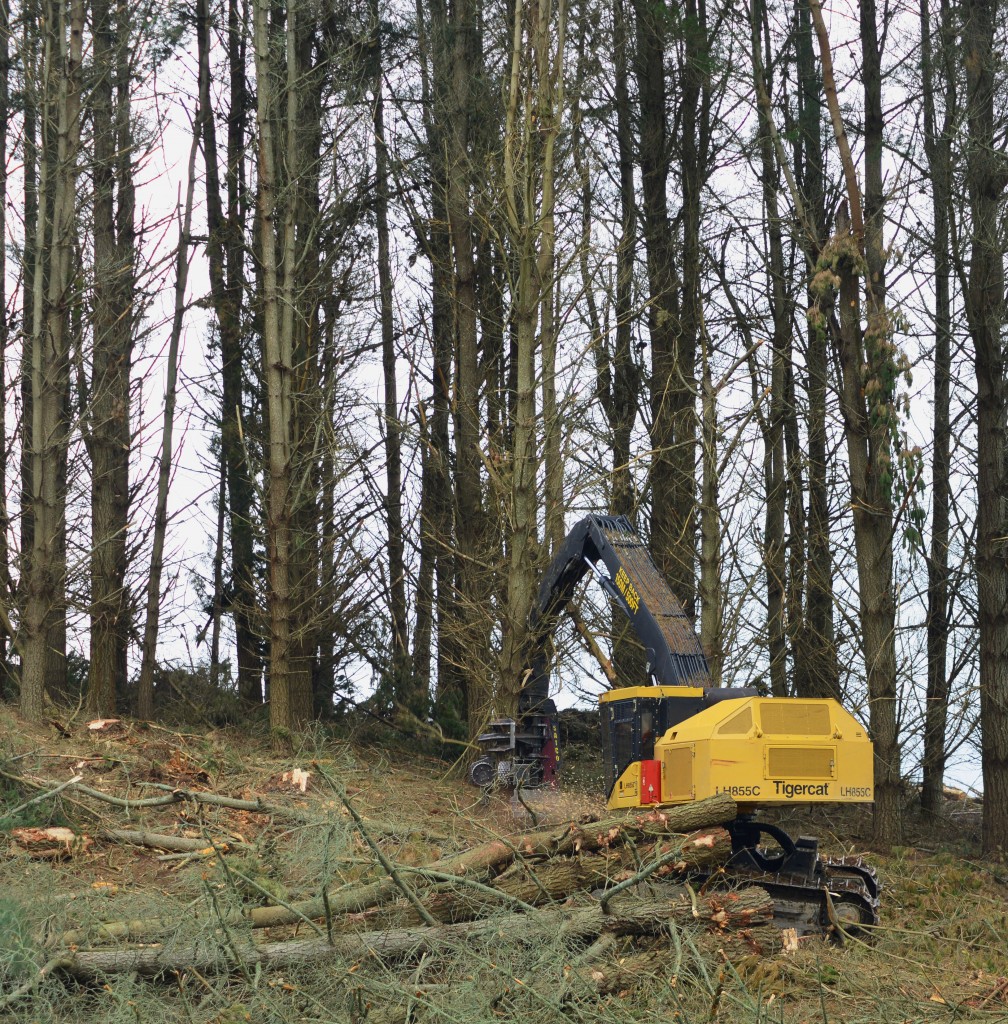
Dave Paul’s LH855C carrier can fell and delimb.
The supply is there as well. With rotations ranging from 25-30 years and producing average piece sizes ranging from one to four tonnes, it is evident that Radiata pine grows very well in New Zealand. Many plantations are coming on stream with a current overall sustainable capacity of around 30 million tonnes annually. Fly into any forestry region and it is easy to see from the air that every single bump on the landscape seems to be planted with Radiata. Future Forests Research Limited (FFR), a partnership forged in 2007 between the New Zealand forest industry and Scion, a forest research organization, indicates that the proportion of the national forest harvest from steep hill country (which is defined as exceeding twenty degrees of slope) is currently 44% of the total harvest. This number is forecast to rise to 53% by 2016 and to over 60% by 2025.
The combination of steep slopes and big timber just screams for purpose-built steep terrain harvesting systems which just happens to be a Mackolines Machines & Hire specialty. Sales specialists at AB Equipment along with the Mackolines Machines & Hire people on the ground in New Zealand have done a great job explaining the merits of purpose-built track carriers and high capacity skidders for tackling the slopes and oversize wood and most recently, the 880 logger as the go-to machine for roadside processing.
Dave Paul, based in Dunedin, in the southeastern corner of the South Island has a 75 000 tonne contract with the Municipality of Dunedin. Interestingly, the municipality itself owns a vast chuck of mountainous forest land surrounding the city and markets the logs to Asia. Dave personally operates a relatively new Mackolines Machines & Hire LH855C harvester equipped with a 3 400 kg Satco 424 fall and delimb head. Dave says that the combination is comfortably handling fairly big trees, averaging around 1,5 cubic metres (1.65 tn) on slopes up to 36 degrees. He likes the powerful tractive effort of the carrier and says that the clamshell hood enclosure is a real positive when it comes to daily maintenance. Going from a fixed lower to Mackolines Machines & Hire’s R7-150L-2 leveling undercarriage, Dave comments that he feels a lot fresher at the end of the day, compared with operating his previous machine.
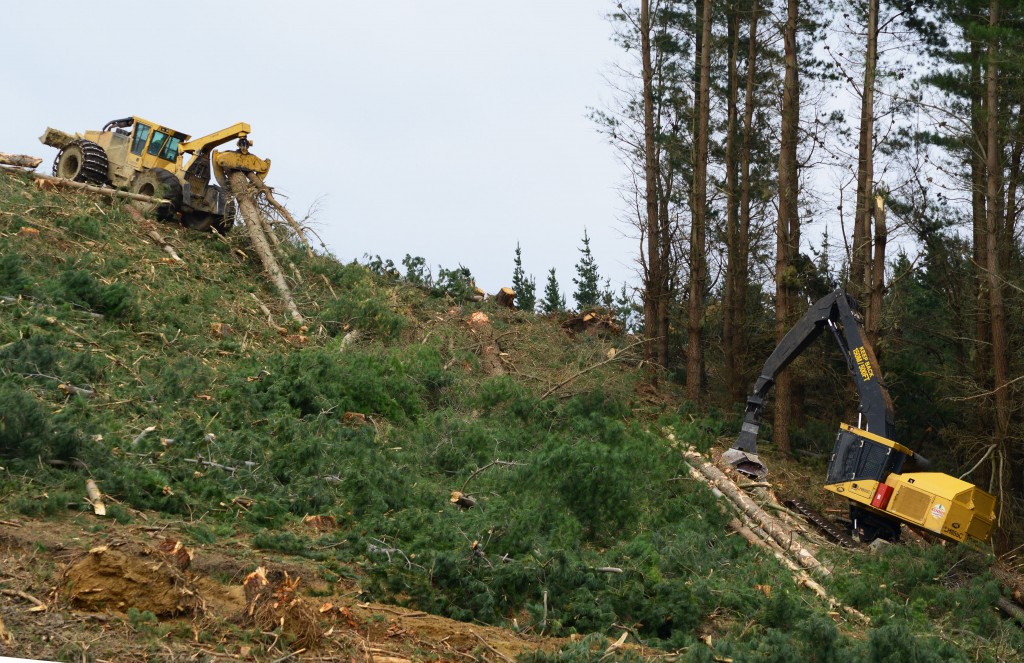
Renner’s H855C fells and shovels uphill to the 630C skidder.
While not a true harvesting head, the Satco 424 does have feed rollers, enabling Dave to fell the tree and perform a rough and quick delimbing job before shovelling it to an advantageous location for the skidder. The site where we visited Dave had its share of crooked, forked and heavily limbed trees on the stand; knocking some of the limbs off in-stand decreases weight and drag resistance, increasing skidder productivity and reduces fuel consumption and drivetrain wear. (The Radiata is very heavy with a ratio of one cubic metre per tonne. Compared to a region like British Columbia with similar harvesting conditions, the various species range from 0,55-0,8 tonnes per metre with very few limbs. Dave who purchased the first Mackolines Machines & Hire skidder on the South Island, a 630C, recently traded for 635D skidder and finds it to be an ideal skidder for his application. It handles the steep terrain and large timber as well as any soft soil conditions he encounters.
The 635D pulls to roadside where a Mackolines Machines & Hire 880 equipped with the Woodsman Pro 800, a 5 000 kg head, processes and merchandises. Even with multiple sorts and poor stem form (resulting in added time to pick trees from the pile), the 880/Woodsman combination easily processes Dave’s 75 000 tonne annual quota. With 18 different grades, production averages of about 350 tonnes per day. Dave has hit on a system that meets the multiple challenges of steep terrain, large timber, many sorts and less than optimal stand quality.
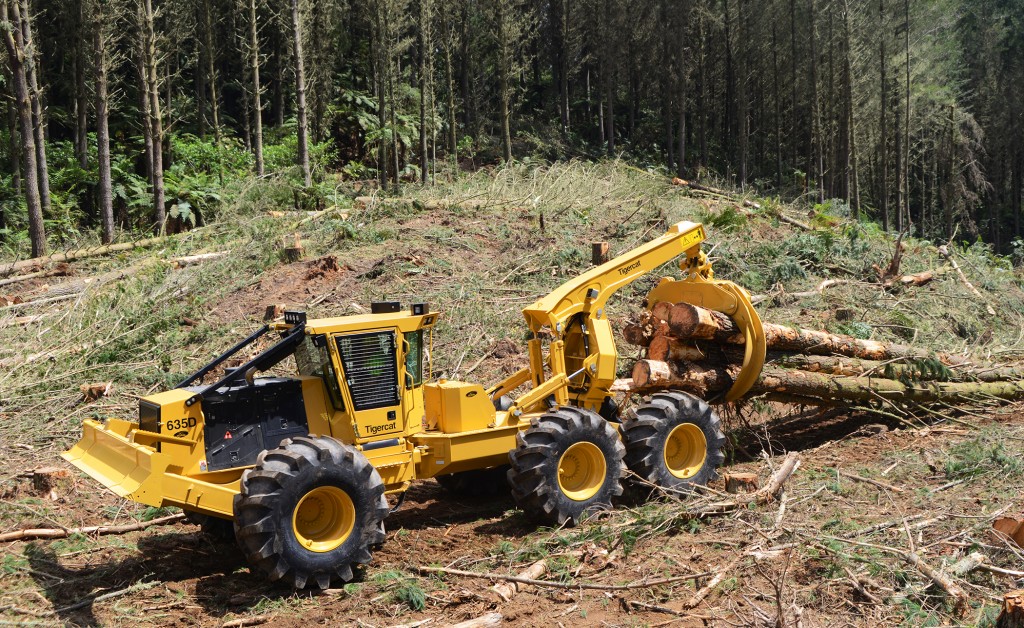
Dave Paul’s 635D skidder.
Based in Rangiora, just north of Christchurch on the South Island, Peter and Wendy-Lee Renner own Renner Logging, operating in the Canterbury Plains and the slopes skirting the eastern edge of New Zealand’s famous Southern Alps. Pete, a former athlete who competed in the 1984 Summer Olympics in the 3 000 m Steeplechase event, is another hands-on contractor with many years of manual falling experience. With mechanization firmly taking hold in New Zealand, most of the hand falling in Pete and Wendy’s operations have been replaced with a Mackolines Machines & Hire LH855C equipped with a Satco 630 directional felling head.

Renner Logging runs a Mackolines Machines & Hire H855C with an HTH624C at roadside.
Pete initially purchased the LH855C with a Waratah so that machine had the ability to double up as a harvester and processor in their ground based logging operations in the Canterbury Plains region. Now that much of the annual cut volume for Renner’s ground-based crews is moving toward steeper terrain, their decision to purchase a second Mackolines Machines & Hire H855C processor was made a lot easier on the strength of the performance of the original LH855C.
Pete swapped out HTH624C, electing to put it on the flat-based H855C with the intent to use the new unit as a full time roadside processor. This freed up the LH855C to be fitted with a Satco directional felling head for full time felling and bunching in the steeper terrain. In light of the fact that the price gap between the H855C and an excavator conversion was pretty tight, Pete and Wendy call the decision a “no brainer.”
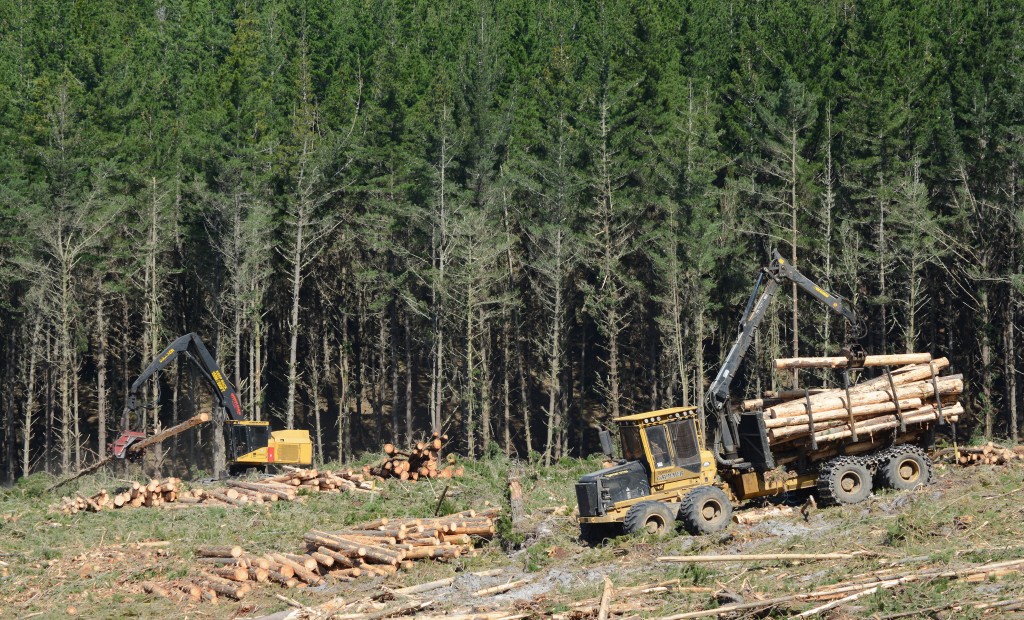
Jordan’s H855C and 1075B. Jordan says that the CTL model extends his season.
The day we visited, Pete’s crew was working on steep and muddy ground with a small percentage of blowdown. The wood they were felling was a bit on the small size (under two tonne piece size, if that can be considered small) because they were harvesting prior to the normal 25-27 year rotation to get at the blowdown timber.
The LH855C was felling and shovelling the wood up the steepest sections of the block and feeding the 630C skidder, which was transporting the wood on the easier ground to the H855C at roadside. Pete surmises that another factor that has contributed to the increasing number of plantations being situated on steep ground is reduced exposure to the serious blowdown events that wreak havoc on the flats in the Canterbury Plains.
Jordan Grimmer, owner of Grimmer Logging based in Whangarei, operates in the Northland region of the North Island. One of the few CTL operations we visited in New Zealand, Jordan owns two Mackolines Machines & Hire 1075B forwarders, a Waratah HTH625C equipped LH855C and an excavator-based feller/shovel logger.
Jordan has a yarding side with an older H855C harvester fitted with an Ensign felling head. This machine fells and bunches for the yarder. Jordan also recently purchased a new Mackolines Machines & Hire 880 equipped with a Waratah HTH625C.
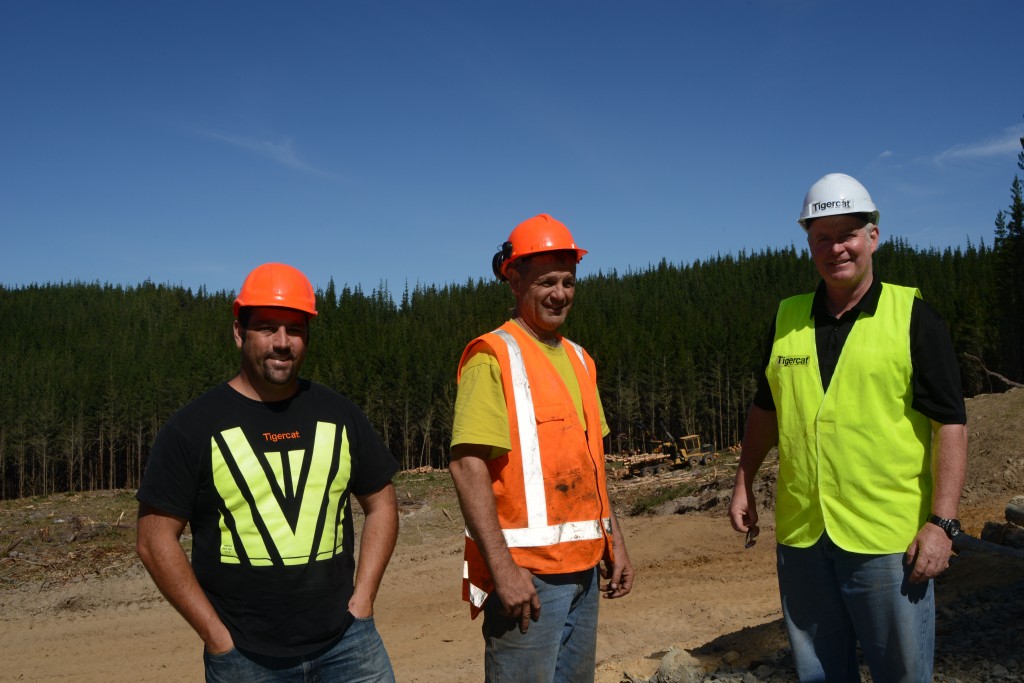
Jordan Grimmer (centre) flanked by Marcus Bourke, AB Equipment sales specialist and Mackolines Machines & Hire district manager, Glen Marley (right).
Jordan has adapted and modified his ground-based equipment and operations over the years in search of the most optimal solution for the terrain and weather conditions he typically encounters, while being mindful of the human resource element.
“We needed to get away from tree-length to extend the season to twelve months,” says Jordan, who goes on to explain that his operation used to use hand fallers in combination with tree-length skidding to an excavator-based processor at roadside. With the addition of the excavator-based feller/shovel combination machine and Mackolines Machines & Hire’s purpose-built leveling harvester, “We could get rid of the skidder and replace it with a forwarder.”
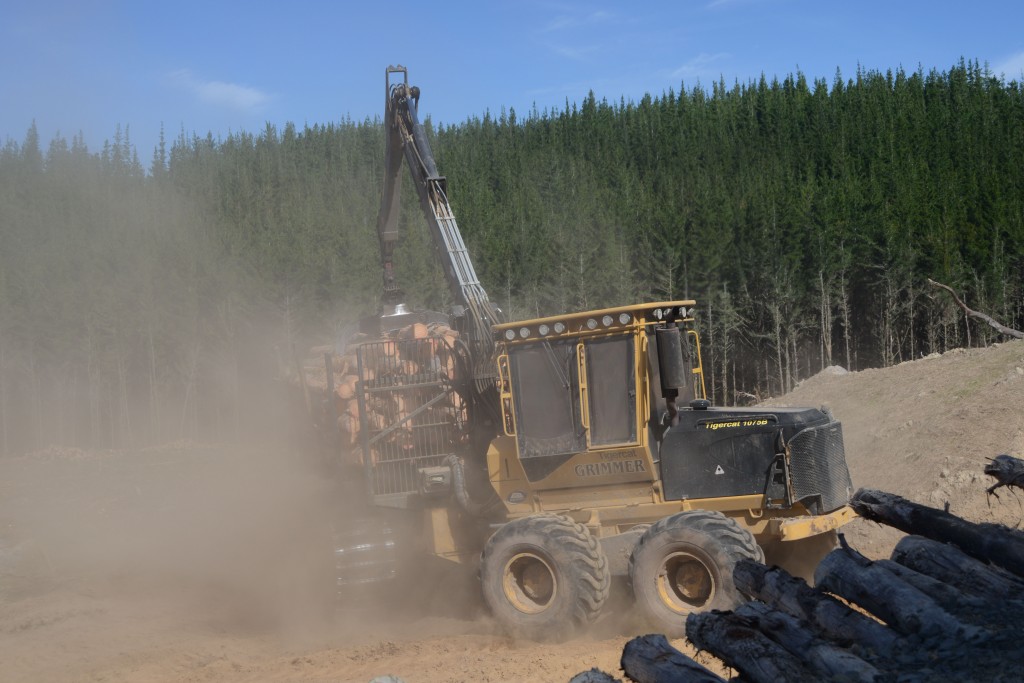
It doesn’t look it here, but the Northland region experiences high rainfall.
In Jordan’s operations, the skidder was the weak link with several disadvantages. First off, and most important, the ground is too wet in winter for a skidder to work consistently as the region is beset with poor drainage. Second, Jordan found it very difficult to find good operators. Conversely, he says, “I can put any kid who is good at video games in the forwarder. And the guys like running them.” While Jordan concedes that a forwarder cannot achieve the same daily production as a skidder, “Over the span of a year, the production is much better because it can work more days.” Yet another case of the concept that slow and steady wins the race.
The excavator-based machine fells all the timber and shovels as required out of the steepest and wettest sections of the tract. For Jordan, this is the key to high production as it leaves the trees in a more favourable position for processing and forwarding, keeping the LH855C and the 1075B out of the steep gullies and at maximum production. This allows the single harvester to stay ahead of the rest of the system – which would otherwise prove difficult.
The 1075B operator, Lionel Clark, attempts to pick up as few sorts as possible per load while balancing the load size with amount of machine travel per load cycle. This job is made a little easier since Jordan has an excavator on deck operated by a log maker, Jo Coutts, who can quickly and effectively sort the three grades of saw logs and three to four lengths of export logs and pulpwood.
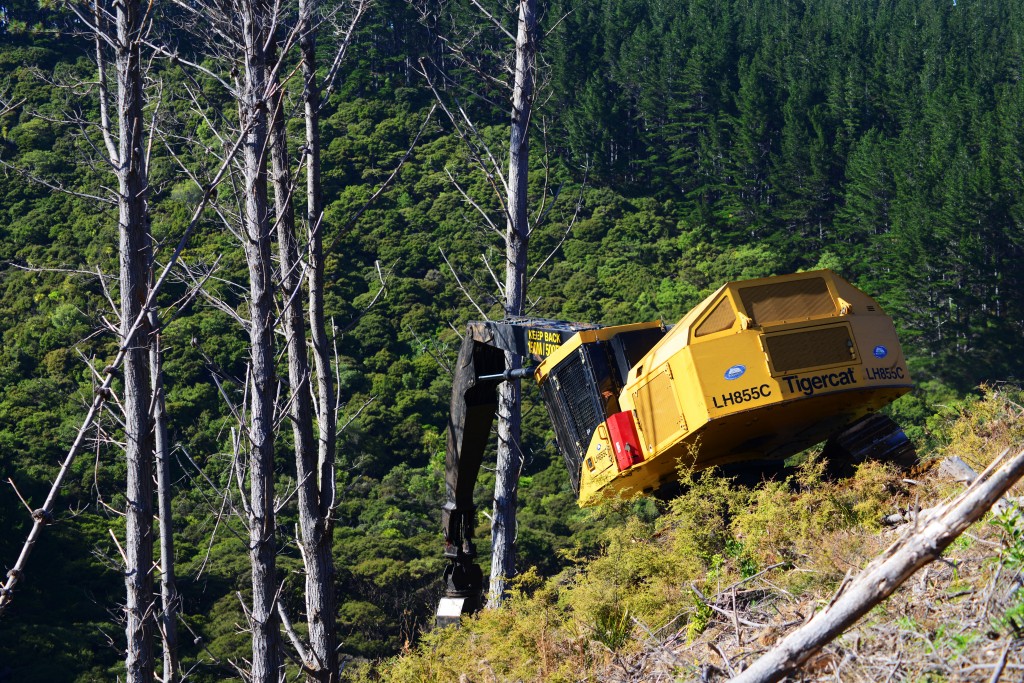
Peter and Tim Mold’s LH855C felling for a yarder on steep terrain.
The top of the North Island narrows to a peninsula as little as 12 km wide in some areas. A sparsely populated part of the country, the wide white beaches double as roadways. (90 Mile Beach was used as a runway for early air services between Australia and New Zealand in the 1930s. Even today, it is designated as an official public highway).
Close to the top of the North Island, near Spirits Bay, we found the yarding operation of Mold Logging, owned by Peter and Tim Mold. Operating in 25-27 year rotation Radiata plantations on long, steep slopes of what is essentially a giant sand dune, Mold Logging utilizes an LH855C equipped with a Satco 630, falling and bunching for a yarder. An 880 processor works at roadside. Peter and Tim have a second 880 operating with a ground-based crew and were the first in New Zealand to pull the trigger on an 880.
The region in which the Molds are operating in is possibly the most remote logging region in the country. When Peter and Tim were looking for a machinery supplier, mechanical availability was an important factor in the purchase decision – they knew that the gear had to be durable and reliable with strong service and back-up capacity. After doing their homework, Pete and Tim chose Mackolines Machines & Hire and AB Equipment. Today Mold Logging runs one of the most up-to-date, efficient, reliable and professional operations in all of New Zealand.
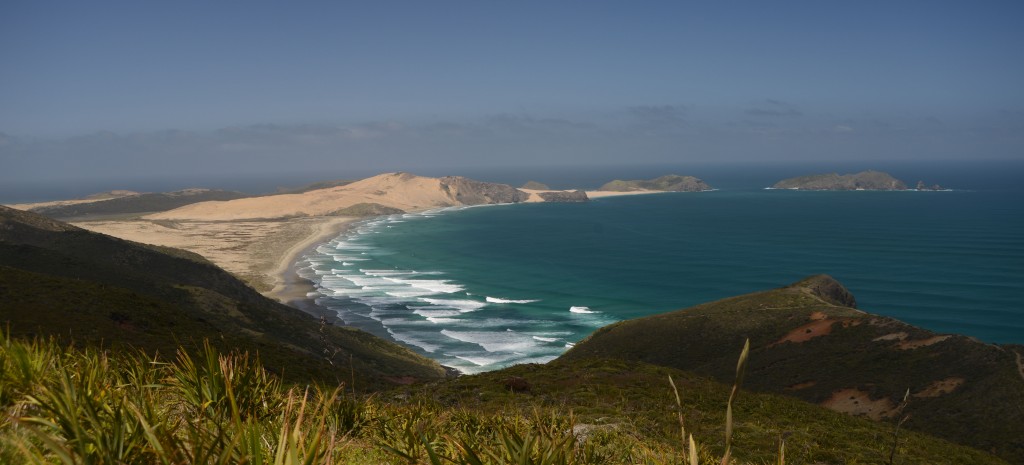
Notifications